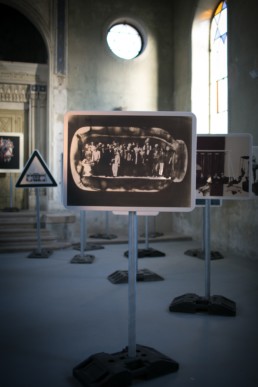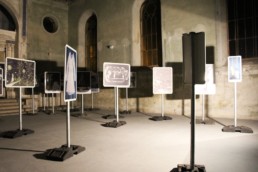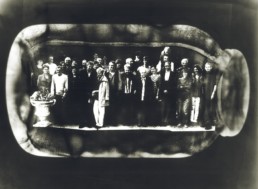Private area at the border of Egopolis – At Home Gallery
Windows and mirrors - Notes on Eva Mayer’s work
Contemplating the last three or four years of Mayer Eva’s work, I unwittingly call to mind two series, each of them forming clearly distinct units. In both cases, one sees pictures that originate in an undeniably strong personal source of inspiration; they are the solidified mementos of the perpetual pursuit of a path, of a home, the visual apparatus of navigation in a world becoming ever less predictable.
For the items from the Private are on the border of Egopolis collection, a talkative (at first glance perhaps even over-talkative) symbolism is characteristic, consciously over-emphasizing the surface of the medium, of the message-bearer (road signposts as points of reference, a web of prohibitions and orders which help us orient ourselves in the maze of the mundane everyday, while simultaneously control and constrain our lives). The surfaces compose a multiply reflective constellation, on one hand in the literal sense of the word with regard to the technical execution (the utilization of light-reflecting foil), on the other hand by reflecting (at the same time unwittingly rewriting, as though dramatizing) particular moments drawn from the artist’s personal past. After all, the signpost-tableaus (movable, transparent elements of Eva Mayer’s memory-infrastructure) abound with references essential in the memory-universe. Here and there, interwoven threads of memory, alienated photo cuttings and other pictorial fragments intertwine, at times resulting in a nearly stifling overflow of private reminiscence, formalised (and ritualised) by the pictures. The visually engaging foils ironed over the traffic signposts - just as set pieces for a physically realised mental map - recall memory fragments from the distant and the near past, oftentimes so that the observer, who has not been confided in, cannot or can hardly make sense of them (contours of aching losses: portrayals of the one passed away, appearing in a medley of variations, just as an ever-returning inner rhyme). Of course, the cornerstones of personal morality, the commands of inner order and intuition are penetrated by public space; the symbolism of society’s expectations, prohibitions and directives is clearly intelligible, as manifested in one of the series’ pieces: Private are on the border of Egopolis (Error and Co.). The artist strives to balance in a pitch-black, airless space, in which the bed seems to be the only point that is fixed and is a source of safety. All around, a suffocating, dense forest of signposts (a signpost within a signpost), a system of norms, uniformed in loud colours and orders, seems to have thoroughly ensnared the intimacy of the space. Thus the bed emerges rather as an arena, the domain for localisation, navigation and compromise.
While the Private are on the border of Egopolis series can be understood to be a system of mirrors to aid orientation, to offer paths and direction, the light-boxes of the Soulspaces-series (the most beautiful results of the artist’s last two years of path-finding, soul-searching), are as if windows open from an inner, seemingly protected space towards an outside world boasting millions of colours and offering a myriad of stimuli. Although at first glance we could be fooled into thinking that these are digital prints pressed on transparent surfaces (or photos edited with image manipulation software), the transparent image fields are the result of a time-consuming, laborious, very much analogue process which amalgamates various graphical treatments and needs special fine-tuning: many of the images are oftentimes the outcome of a careful overlay of several coats of light and colour. Just as if one were trying to glimpse outwards through the colourful stained glass windows of a church’s haven, out towards the inconceivably large and incomprehensibly chaotic environment, the “outside world”- despite all its flamboyance and intrigue - once sifted through the surface of the light-boxes, appears as a gigantic, faceless and uniform continuum. In the infinite forest of skyscrapers not one point of support is to be found to help our orientation. We know that behind each and every one of the countless windows, there are people (workforce!) labouring away. Nevertheless, we see no faces, stares or individuals: we are merely presented with an anonymous mass made of partially abstract smudges and markings. Infusing this Babelian spectacle, at places there are textures grouped into tiny dots, which could easily get lost in the turmoil of light unless, in possession of some mindfulness, we are able to discern that these are the biblical Ten Commandments, engraved in Braille. The presence of refined, extension-like elements poses the question of whether we still have rules of universal power that might provide inner fortitude, and if so, whether we are still able to recognise them adequately, to read and renew them, or do they irreversibly fade from our perception, perhaps to blend in with the passing mirage of the outside world full of loud stimuli and shiny trinkets.
Máté Csanda



























